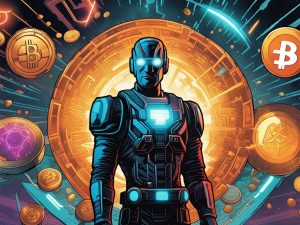Exploring Cryptocurrency ETFs: XRP and Cardano’s Future Outlook
When it comes to the potential for cryptocurrency Exchange-Traded Funds (ETFs), not all digital assets are on equal footing. GSR’s recent analysis delves into the realm of ETFs across various cryptocurrencies, shedding light on the challenges faced by XRP and Cardano in adapting to this financial product.
Decentralization Scores: A Crucial Factor for XRP and Cardano
Decentralization plays a crucial role in assessing a cryptocurrency’s viability for an ETF, considering factors such as permissionless participation and network hardware diversity.
- The Nakamoto Coefficient, a key metric, reveals the concentration of operational power within a network, showcasing vulnerabilities to collusion or control by multiple entities.
- XRP and Cardano received notably low decentralization scores in GSR’s evaluation, with XRP at -0.9 and Cardano at -0.1, raising concerns about their network structures.
In addition to decentralization, the demand potential of a cryptocurrency is equally significant, taking into account market cap, trading volume, and community activity levels.
Demand Metrics Evaluation
Market cap, trading volume, and community activity serve as predictive indicators to gauge the interest in an ETF based on a particular cryptocurrency.
- XRP and Cardano scored -0.2 and -0.5 in demand metrics, positioning them behind other cryptocurrencies with stronger future market demand indicators.
Challenges Ahead for XRP and Cardano
GSR’s analysis paints a challenging picture for XRP and Cardano, as their lower decentralization and demand scores suggest significant obstacles in the path to launching their ETFs.
Positive Outlook for Solana and Other Cryptocurrencies
Contrary to XRP and Cardano, cryptocurrencies like Ethereum, Solana, and NEAR are receiving more optimistic evaluations in GSR’s report.
ETF Possibility Scores
GSR’s methodology assigns a 33% weight to decentralization and 67% weight to demand in the ETF Possibility Score, providing a comprehensive view of each cryptocurrency’s potential for an ETF.
VanEck, a prominent player in asset management, has taken a bold step by filing for the first-ever Spot Solana ETF with the US Securities and Exchange Commission (SEC).
This move underscores Solana’s emergence as a strong competitor to Ethereum, with its scalability, speed, and low costs enhancing the user experience across various use cases.
The Future of Bitcoin and Ethereum ETFs
While Bitcoin spot ETFs have seen fluctuating inflows, Ethereum’s potential ETF is pending final S-1 approvals, expected to come to fruition soon.
Market reactions to these developments have been cautious, reflecting the slow inflows for spot Bitcoin ETFs despite recent positive trends.
Hot Take: Navigating the Evolving Landscape of Cryptocurrency ETFs
The realm of cryptocurrency ETFs is expanding, but not all digital assets are ready for this financial product. GSR’s analysis highlights the challenges faced by XRP and Cardano in adapting to ETFs due to decentralization and demand score concerns.





 By
By
 By
By

 By
By
 By
By
 By
By